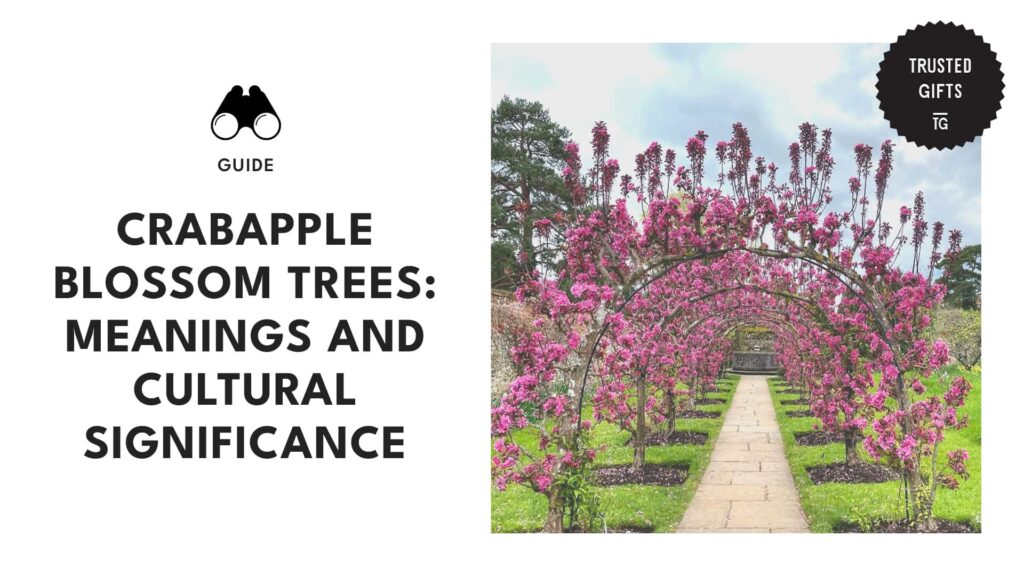Among the most awaited trees to bloom during spring are crabapple blossom trees. It’s pretty understandable, considering how beautiful and ethereal they make every garden and park look.
However, there’s more to these pink blooms than just their aesthetic value. They hold several meanings and cultural significance also worthy of appreciation.
In this guide, we’ll unveil all the simple yet deep meanings hidden in these trees. We’ll also discuss their cultural significance and the many uses that make them one of our favorite trees.
How did the crabapple blossom tree get its name?


The term “crabapple” or “crabæppel” is a combination of the words “crab” and “æppel.” The term “crab” refers to something bitter or sour, while “æppel” refers to apple fruits.
The term “crab” is associated with bitterness and sourness and the facial expression people make when tasting something sour or bitter, similar to the expression of someone bitten by a crab.
What is the botanical origin of the crabapple blossom tree?


The crabapple blossom tree or Malus genus belongs to the Rosaceae family, which also includes roses, plums, and strawberries. It was first discovered in Central Asia, specifically in the Tian Shan mountain range.
Around the 18th century, the Romans brought crabapple blossom trees to Europe, marking the beginning of the tree’s growing popularity. Due to their beauty, plant breeders around the world started cultivating various species of the tree.
There are currently 32 recognized species of crabapple flower trees, and they can be found growing all over the world.
Where do crabapple blossom trees grow?
Crabapple blossom trees can be found growing in temperate regions of Europe, America, and Asia. They are cultivated all over the world since they can adapt to different climate conditions.
Do crabapple blossom trees require maintenance?
Crabapple blossom trees may look elegant and high-maintenance, but they’re actually relatively easy to care for. They’re very resilient and versatile plants that can be forgiving if you accidentally neglect them for some time.
Typically, all they need to flourish are regular watering, sun exposure, and occasional trimming.
Do crabapple blossom trees require shade or sun?
Crabapple blossom trees thrive in full sun, so if you want to see them at their best, provide at least six hours of sunlight daily. That said, they can still flourish in partial shade, as they’re very adaptable.
When do crabapple blossom trees bloom?
The crabapple’s blooming period varies based on the species and environment.
Crabapple blossoms generally bloom in spring, typically from late April to early June. However, the blossoms grown in regions with cooler climates may only start blooming in late spring.
What kind of soil is best for crabapple blossom trees?
Crabapple blossom trees flourish when planted in well-draining, sandy, or loamy soil. Although they can tolerate a range of pH levels, their roots tend to establish better when the soil is within the 6.0 to 7.0 range.
It’s crucial that the soil doesn’t become waterlogged because crabapple blossom trees are quite susceptible to root rot. Adding perlite or vermiculite to the soil mix can help avoid overwatering, resulting in a healthier crabapple blossom.
When is the best time to plant crabapple blossom trees?
The best time to plant crabapple trees is in late fall planting. It helps them establish a strong and healthy root system before the winter comes.
Though the air is cooler during this time, the soil is warm enough to encourage the plant to focus on growing roots instead of foliage.
What do crabapple blossom trees mean?


Crabapple blossom trees’ abundant flowering during spring has led many to link them with fertility, love, and marriage. Their ability to produce a profuse number of blooms every spring is often seen as a metaphor for reproduction.
Additionally, crabapple blossoms symbolize renewal and new beginnings. Their flowers signify the end of winter and the beginning of a new season, encouraging everyone to start anew and grow as individuals.
What do the different colors of crabapple blossom trees mean?


What did the crabapple blossom tree symbolize in different historical periods?


What are the cultural associations of the crabapple blossom tree?


What are the uses of the crabapple blossom tree?


Crabapple blossom trees are widely used for gardening and gifting due to their ornamental value, but there’s more to them than their beauty. They can be used to treat some illnesses or mixed with other ingredients to make delicious desserts.
Can crabapple blossom trees be used in medicine?


Yes, crabapple blossom trees, specifically the bark and fruit, were traditionally used in herbal medicine. They were often used to treat digestive problems and skin irritations.
The tree’s fruit has a mild laxative effect that can stimulate the digestive system and help those experiencing constipation. The flowers also contain anti-inflammatory properties that can help soothe skin irritations and treat wounds.
If you’re planning to use any part of a crabapple blossom tree for medical reasons, it’s advisable to consult a healthcare professional. The studies that support the efficacy of the blossoms in treating any medical problem are limited, so use them with caution.
How can crabapple blossom trees be used in cooking?


Crabapples can be used to make delicious syrups, jams, jellies, and butter. The blossoms can also be used as a garnish for salads and other dishes to add a touch of elegance to the presentation.
Although crabapples are quite sour, mixing them with your favorite sweetener can result in a tasty jam, jelly, and sauce. You can also mix them with cinnamon and nutmeg to make crabapple butter that you can use for various dishes.
If you’re really not fond of the crabapple fruit’s taste, you can still incorporate the blossom in your dish presentation. Just ensure that the tree you’ll get the blossoms from is free from pesticides or other harmful contaminants.
How can crabapple blossom trees be used in gardening?


One of the best ways you can use a crabapple blossom tree in your garden is by planting it as a standalone ornamental tree and making it the focal point of your garden.
Crabapple blossom trees are attention-grabbing and can add a sense of elegance to your garden. They produce showy, flagrant blossoms during spring, allowing you to enjoy a beautiful and fragrant garden.




